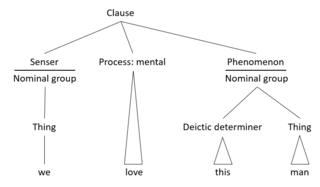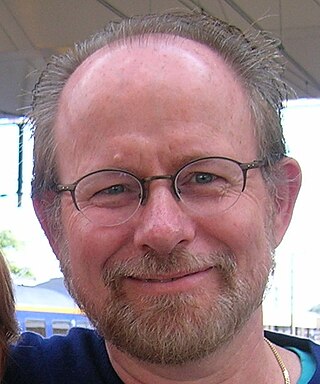Related Research Articles

Functional linguistics is an approach to the study of language characterized by taking systematically into account the speaker's and the hearer's side, and the communicative needs of the speaker and of the given language community. Linguistic functionalism spawned in the 1920s to 1930s from Ferdinand de Saussure's systematic structuralist approach to language (1916).
In linguistics, syntax is the study of how words and morphemes combine to form larger units such as phrases and sentences. Central concerns of syntax include word order, grammatical relations, hierarchical sentence structure (constituency), agreement, the nature of crosslinguistic variation, and the relationship between form and meaning (semantics). There are numerous approaches to syntax that differ in their central assumptions and goals.
Cognitive linguistics is an interdisciplinary branch of linguistics, combining knowledge and research from cognitive science, cognitive psychology, neuropsychology and linguistics. Models and theoretical accounts of cognitive linguistics are considered as psychologically real, and research in cognitive linguistics aims to help understand cognition in general and is seen as a road into the human mind.
Applied linguistics is an interdisciplinary field which identifies, investigates, and offers solutions to language-related real-life problems. Some of the academic fields related to applied linguistics are education, psychology, communication research, information science, natural language processing, anthropology, and sociology. Applied linguistics is a practical use of language.

Generative grammar is a research tradition in linguistics that aims to explain the cognitive basis of language by formulating and testing explicit models of humans' subconscious grammatical knowledge. Generative linguists tend to share certain working assumptions such as the competence-performance distinction and the notion that some domain-specific aspects of grammar are partly innate. These assumptions are rejected in non-generative approaches such as usage-based models of language. Generative linguistics includes work in core areas such as syntax, semantics, phonology, psycholinguistics, and language acquisition, with additional extensions to topics including biolinguistics and music cognition.

The Association for Computational Linguistics (ACL) is a scientific and professional organization for people working on natural language processing. Its namesake conference is one of the primary high impact conferences for natural language processing research, along with EMNLP. The conference is held each summer in locations where significant computational linguistics research is carried out.
Rodney D. Huddleston is a British linguist and grammarian specializing in the study and description of English.
Geoffrey Keith Pullum is a British and American linguist specialising in the study of English. Pullum has published over 300 articles and books on various topics in linguistics, including phonology, morphology, semantics, pragmatics, computational linguistics, and philosophy of language. He is Professor Emeritus of General Linguistics at the University of Edinburgh.
Jan Koster is a Dutch linguist and professor emeritus at the University of Groningen.
The generative approach to second language (L2) acquisition (SLA) is a cognitive based theory of SLA that applies theoretical insights developed from within generative linguistics to investigate how second languages and dialects are acquired and lost by individuals learning naturalistically or with formal instruction in foreign, second language and lingua franca settings. Central to generative linguistics is the concept of Universal Grammar (UG), a part of an innate, biologically endowed language faculty which refers to knowledge alleged to be common to all human languages. UG includes both invariant principles as well as parameters that allow for variation which place limitations on the form and operations of grammar. Subsequently, research within the Generative Second-Language Acquisition (GenSLA) tradition describes and explains SLA by probing the interplay between Universal Grammar, knowledge of one's native language and input from the target language. Research is conducted in syntax, phonology, morphology, phonetics, semantics, and has some relevant applications to pragmatics.
Ray C. Dougherty is an American linguist and was a member of the Arts and Science faculty at New York University until 2014 (retired). He received his bachelor's and master's degrees in engineering from Dartmouth College in the early 1960s and his Ph.D. in linguistics from the Massachusetts Institute of Technology in 1968. At MIT, Dougherty was one of the first students of Noam Chomsky, working in the field of transformational grammar. During the Linguistics Wars of the 1970s, Dougherty was a critic of the generative semantics movement. Specializing in computational linguistics, Dougherty has published several books and articles on the subject.
Language assessment or language testing is a field of study under the umbrella of applied linguistics. Its main focus is the assessment of first, second or other language in the school, college, or university context; assessment of language use in the workplace; and assessment of language in the immigration, citizenship, and asylum contexts. The assessment may include listening, speaking, reading, writing, an integration of two or more of these skills, or other constructs of language ability. Equal weight may be placed on knowledge and proficiency, or greater weight may be given to one aspect or the other.
Linguistics is the scientific study of language. Linguistics is based on a theoretical as well as a descriptive study of language and is also interlinked with the applied fields of language studies and language learning, which entails the study of specific languages. Before the 20th century, linguistics evolved in conjunction with literary study and did not employ scientific methods. Modern-day linguistics is considered a science because it entails a comprehensive, systematic, objective, and precise analysis of all aspects of language – i.e., the cognitive, the social, the cultural, the psychological, the environmental, the biological, the literary, the grammatical, the paleographical, and the structural.
"Conditions on Transformations" is an article on linguistics by Noam Chomsky, published in 1973. In it, Chomsky attempted to formulate constraints on transformational rules used in Transformational Generative Grammar (TGG), a syntactic theory that Chomsky first proposed in the 1950s. These constraints, or "conditions", helped decrease the number of possible generative grammars, with a goal to account for the process of language acquisition in children.
Lauri Juhani Karttunen was an adjunct professor in linguistics at Stanford and an ACL Fellow. He died in 2022.

In linguistics, the term formalism is used in a variety of meanings which relate to formal linguistics in different ways. In common usage, it is merely synonymous with a grammatical model or a syntactic model: a method for analyzing sentence structures. Such formalisms include different methodologies of generative grammar which are especially designed to produce grammatically correct strings of words; or the likes of Functional Discourse Grammar which builds on predicate logic.
In computational linguistics, the term mildly context-sensitive grammar formalisms refers to several grammar formalisms that have been developed in an effort to provide adequate descriptions of the syntactic structure of natural language.

Harry van der Hulst is full professor of linguistics and director of undergraduate studies at the department of linguistics of the University of Connecticut. He has been editor-in-chief of the international SSCI peer-reviewed linguistics journal The Linguistic Review since 1990 and he is co-editor of the series ‘Studies in generative grammar’. He is a Life Fellow of the Netherlands Institute for Advanced Study, and a board member of the European linguistics organization GLOW.
Henk van Riemsdijk is a Dutch linguist and professor emeritus at Tilburg University.
References
- ↑ "GLOW in Asia conferences". GLOW in Asia. Archived from the original on February 25, 2024. Retrieved June 15, 2024.